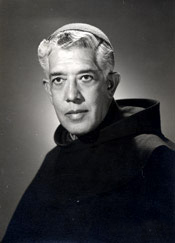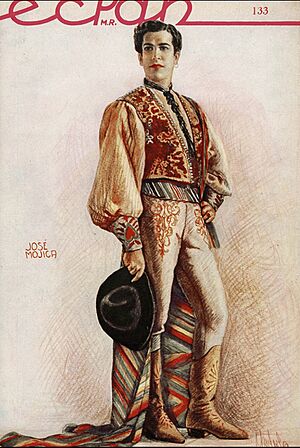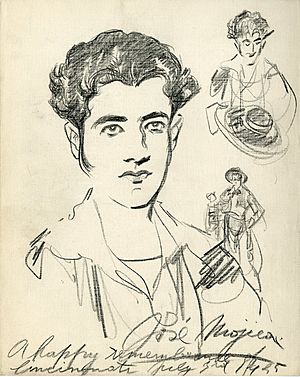José Mojica facts for kids
Quick facts for kids
José Mojica
|
|
|---|---|
 |
|
| Born |
Crescenciano Abel Exaltación de la Cruz José de Jesús Mojica Montenegro y Chavarín
14 September 1895 San Gabriel, Jalisco, Mexico
|
| Died | 20 September 1974 (aged 79) Lima, Peru
|
| Other names | Fray José de Guadalupe Mojica, OFM |
| Occupation |
|
| Years active | 1947–1974 (religious) 1930–1966 (actor) 1919–1940 (opera singer) |
| Organization | Franciscan |
Fray José de Guadalupe Mojica (born September 14, 1895 – died September 20, 1974) was a talented Mexican Franciscan friar. Before becoming a friar, he was a famous tenor (a male opera singer) and a film actor. In the music and film world, he was known simply as José Mojica.
Mojica became part of the American film industry before he chose a religious life. He was one of the few Mexican stars who made history in the early days of Hollywood. Other famous Mexican actors at that time included Dolores del Río, Tito Guízar, Ramón Novarro, and Lupe Vélez. Mojica believed that religion and art could work together. He once said, "If God gave me the grace of voice and singing skills, I use them for His glory."
Contents
Early Life and Beginnings
José Mojica was born in San Gabriel, Jalisco, Mexico. He grew up on a coffee and sugar farm until he was six years old. His stepfather, Francisco, passed away, and he never knew his birth father. Later, his mother's family faced money problems. They moved to Mexico City with very little. There, José studied at the Academy of San Carlos and then at the National School of Agriculture.
Mojica wrote about his experiences during the Mexican Revolution in his book, "I, a Sinner." This was a time of armed conflict in Mexico. The military academy he attended even closed because of it. These events helped him discover what he truly wanted to do. He started taking private singing lessons while studying at the National Conservatory of Music of Mexico.
At the Conservatory, Mojica also learned acting. He was very good at languages, mastering English, Italian, and French. He also learned to play the guitar, sing Mexican songs, and practiced dance, sports, and horse riding. He soon began working as an opera singer at the Teatro Ideal. On October 5, 1916, he performed for the first time at the Teatro Arbeu. He played the role of Count Almaviva in Rossini's opera The Barber of Seville. The next year, he played Rodrigo in Verdi's opera Otello.
Career in the United States
Soon after the United States entered World War I, Mojica moved to New York City. He had only $500. He worked small jobs before joining an opera company. In his free time, he watched performances by the famous singer Enrico Caruso at the Metropolitan Opera. Caruso met Mojica in 1919 and was impressed by his voice. He helped Mojica get a contract with the Chicago Civic Opera company. On November 22, Mojica performed a small role in Lucia di Lammermoor. This opera was based on a novel by Sir Walter Scott.
While in Chicago, Mojica took on smaller roles. His career grew in 1921 when he played main parts. He starred in Debussy's Pelléas et Mélisande and Prokofiev's The Love for Three Oranges. In the first opera, he sang alongside the famous soprano (female opera singer) Mary Garden. Prokofiev even watched Mojica's rehearsals. Mojica also became friends with Feodor Chaliapin. Under Chaliapin's guidance, he played Shúyskiy in Mussorgsky's Boris Godunov.
In 1924, Mojica sang three roles at the San Francisco Opera. He played Pinkerton in Madama Butterfly, Rinuccio in Gianni Schicchi, and Rodolfo in La Boheme. These were his only performances in San Francisco.
Caruso helped Mojica's career in two other ways. First, he suggested Mojica to Edison to become one of Edison's Three Tenors. Second, Caruso sent letters of introduction with Mojica to Hollywood. Young voices were needed there to sing in 'talkies' (early movies with sound). Mojica went to California. Except for trips back to Chicago and New York for singing, his career continued in films. He also performed throughout Latin America.
In 1933, after leaving Chicago, Mojica traveled across the Atlantic Ocean. He sang at the Mexican Embassy in Berlin and performed in Italy and Egypt. He also returned to the Chicago Opera in 1940. There, he played Fenton in Verdi's Falstaff.
Recording Career
José Mojica recorded many songs, showing how talented he was. He made recordings for Edison and the Victor Talking Machine Company.
By 1925, Mojica was a key singer at the Chicago Opera. He was getting main roles. He left Edison and joined Victor in 1927. He made several successful early sound films. In the 1930s, he moved easily between opera, films, and concerts. But in 1943, he left this life to become a priest. Like Edison, Mojica later became completely deaf.
His popular music recordings show his beautiful voice. He used his skills and imagination in songs like Júrame. This song was written for him by María Grever. It was released by Victor in 1927. The song quickly became a hit. Many singers have recorded it over the years.
Hollywood Career
Besides his opera work, Mojica also became an actor in Hollywood. He met film directors, including King Vidor. Mojica wanted to build a large home called a hacienda. It would have a music room to show off his talent. Vidor introduced him to architect John Byers. Byers had just finished designing Vidor's home. Mojica told everyone he was building his mother a "copy of the hacienda her family had lost." This was during a time when church lands were taken by the government. This comment annoyed Byers, so he removed the hacienda from his list of designs.
The Hacienda Mojica was in Santa Monica Canyon. Mojica lived there with his mother, Dona Virginia. It was a beautiful place near Santa Monica Creek. His neighbors included Leo Carrillo and Dolores del Río. The area was part of an old Mexican land grant. This home was Mojica's "showcase." He often hosted parties, and it became a hub for Hollywood's Latino actors. Actors felt it was a place where they could relax and be themselves.
This home helped him get attention from nearby film studios. Mojica signed a contract with Fox Film Corporation in 1930. He made his first film that same year. It was a romantic musical called One Mad Kiss (1930). He played a Spanish outlaw and starred with Argentine actress Mona Maris. He also starred with her in other films. He often worked with Spanish actresses Conchita Montenegro and Rosita Moreno. As an actor, he played many different roles. These included Latin lovers, a Russian soldier, a Sultan, and even the legendary Dick Turpin. For the rest of the 1930s, he also made films in Argentine, Mexico, Peru, and Spain.
Before he retired, Mojica sang the song Solamente una vez. Agustín Lara wrote it for the 1941 film Melodías de América. This song later became famous as You Belong to My Heart. Ray Gilbert wrote the English words. Many artists have recorded it, including Andrea Bocelli, Nat King Cole, Bing Crosby, Charlie Haden, and Elvis Presley.
Antigua Villa Santa Monica
Antigua Villa Santa Monica is in San Miguel de Allende. This is a city in the state of Guanajuato, Mexico. This large estate was built in the 1600s. It was made with money from Spanish silver mines nearby. The villa was left empty for years after the Mexican Revolution. Mojica bought it in 1933 and rebuilt it for his mother. Her health was getting worse. Mojica loved the beauty of this city. He hosted many grand parties at Villa Santa Monica. He named it after his home in California.
He enjoyed introducing his famous friends to the beauty of the Colonial City. His guests included composers, writers, opera stars, actors, and painters. Mojica dreamed of San Miguel becoming a center for art. Guests like María Félix, Dolores del Río, Pedro Armendáriz, Gary Cooper, John Ford, John Huston, Pedro Infante, Agustín Lara, Jorge Negrete, Pedro Vargas, and John Wayne visited his villa. Today, some trees on the property have nameplates of the celebrities who planted them. Mojica met two young Americans traveling by train in Mexico. He invited them to visit him in San Miguel. They did, and later they founded Belles Artes and the Instituto Allende. Today, San Miguel de Allende honors Mojica as a Distinguished Citizen. His former home is now Hotel Villa Santa Monica, a luxurious B&B. The street it's on is named Padre Mojica. The Antigua Villa Santa Monica became a fancy hotel in the mid-1940s after his mother passed away.
His mother's death in 1942 made him think about his life. Two years later, he left his acting career. He joined the Franciscan Order in Peru. He gave most of his money and property to the religious order. But first, he gave money to an orphanage in San Miguel.
Religious Life
Even after he stopped acting, Mojica sometimes performed. He did this to help raise money for good causes. After his career, he went to Cuzco, Perú. He entered the Monastery of San Francisco, Lima and took the name Fray Francisco José de Guadalupe Mojica. He became a priest on July 13, 1947. Peruvian Cardinal Juan Gualberto Guevara made him a priest.
In Lima, Fray Mojica started a school to train priests. But he still loved the stage. Mojica began directing plays with amateur actors. Later, he became a painter to continue his artistic work. In the 1950s and 1960s, he appeared in a few films. He did this to collect money for his religious order. In 1954, he even went on a concert tour in Central America to raise funds.
Mojica started to lose his hearing temporarily. His leaders asked him to write his life story. This stopped his singing. He finished his book, Yo pecador... (I, a Sinner) in 1956. The book sold over three million copies in Spanish. It was translated into English in 1963. A movie based on the book, with the same title, came out in 1959.
Death
Mojica eventually lost his hearing completely and became deaf. He suffered for years from a liver problem called hepatitis. He died in 1974 from heart failure. He passed away at the Monastery of San Francisco in Lima. This was just six days after his 79th birthday.
Notable Recordings
| Date | Title | Composer | Label |
|---|---|---|---|
| 1924 | Al pie de tu ventana | Traditional serenade | Edison 80794 |
| 1924 | Eres tú | Alfonso Esparza Oteo | Edison 80792 |
| 1924 | Golondrina mensajera | Alfonso Esparza Oteo | Edison 80792 |
| 1924 | Princesita | José Padilla | Edison 80794 |
| 1925 | El Nopal | Mario Talavera | Edison 60047-L |
| 1925 | Lejos de ti | Manuel M. Ponce | Edison 60049-L |
| 1925 | Marchita el alma | Manuel M. Ponce | Edison 82344-L |
| 1926 | Una furtiva lagrima (L'elisir d'amore) | Gaetano Donizetti | Edison 82344-A |
| 1926 | Gratia plena | Mario Talavera/Amado Nervo | Edison 76018-L |
| 1926 | Lolita | Arturo Buzzi-Peccia | Edison 82344-L |
| 1927 | Pais azul | Jorge del Moral | Victor 40020 |
| 1927 | Pasas por el abismo | Jorge del Moral/Amado Nervo | Victor 40021 |
| 1927 | Júrame | María Grever | Victor 40023 |
| 1927 | Gratia plena | Mario Talavera/Amado Nervo | Victor 40026 |
| 1928 | Salve, dimora | Charles Gounod | Victor 42962 |
| 1928 | Czar Berendey's cavatine | Nikolai Rimsky-Korsakov | Victor 42963 |
| 1930 | Oh! Where are you? | José Mojica/Troy Sanders | Victor 58579 |
| 1930 | One mad kiss | José Mojica/Troy Sanders | Victor 58658 |
| 1930 | Behind the mask | James F. Hanley/Joseph McCarthy | Victor 58659 |
| 1930 | Lament | José Mojica/Dudley Nichols | Victor 58662 |
| 1930 | ¿En dónde estás? | José Mojica/Troy Sanders | Victor 62644 |
| 1930 | Un beso loco | José Mojica/Troy Sanders | Victor 62645 |
Filmography
| Year | Title | Country | Genre | Role | Refs |
|---|---|---|---|---|---|
| 1930 | One Mad Kiss | United States | Musical/Romance | José Salvedra | |
| 1930 | Cuando el amor ríe | United States | Drama/Romance | Emilio Rodríguez de Viana | |
| 1931 | Hay que casar al príncipe | United States | Comedy/Romance | Prince Alexis | |
| 1931 | La ley del harem | United States | Musical/Romance | Prince Al-Hadi | |
| 1931 | Mi último amor | United States | Comedy | Fernando Urrutia | |
| 1932 | El caballero de la noche | United States | Adventure | Dick Turpin | |
| 1933 | El rey de los gitanos | United States | Musical/Romance | Karol | |
| 1933 | Melodía prohibida | United States | Drama | Kalu | |
| 1934 | La cruz y la espada | United States | Drama | Hermano Francisco | |
| 1934 | Un capitan de Cosacos | United States | Drama | Sergio Danikoff | |
| 1934 | Las fronteras del amor | United States | Comedy/Musical/Romance | Miguel Segovia | |
| 1939 | The Adventurous Captain | United States | Adventure/Musical/Romance | don Gil de Alcalá | |
| 1940 | The Miracle Song | Mexico | Musical/Drama/Family | Ramón | |
| 1941 | Melodies of America | Argentina | Comedy/Musical | as himself | |
| 1953 | El pórtico de la gloria | Spain | Melodrama/Religion | as himself | |
| 1959 | Yo pecador | Mexico | Drama/Musical/Religion | as himself | |
| 1966 | Seguiré tus pasos | Mexico/Peru | Family/Drama/Religion | as himself |
See also
 In Spanish: José Mojica para niños
In Spanish: José Mojica para niños



